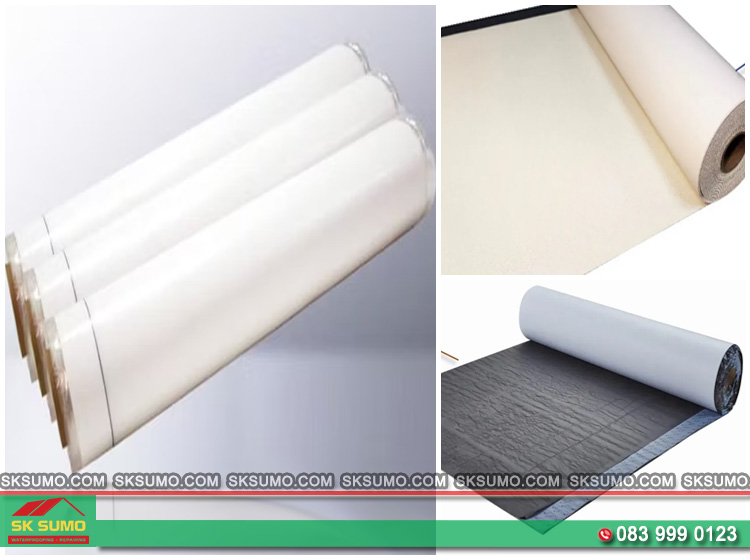Roll 50-100m, thick 1.2mm

In residential and industrial construction, especially in components that directly contact soil or are frequently exposed to water pressure, choosing a safe, durable, and stable waterproofing material is a key factor in determining the lifespan of the structure. Among modern materials, the GPS HDPE 1.2mm waterproofing membrane is prioritized by many engineers thanks to its high watertightness and excellent deformation resistance.
The GPS HDPE 1.2mm waterproofing membrane is a synthetic membrane made from virgin HDPE combined with GPS (Geo-Polymer Stabilized) technology to enhance stress stability. With a technical thickness of 1.2mm, it is designed for construction applications such as waterproofing foundations, basements, rooftops, underground water tanks, fire protection tanks, machinery areas, and other moisture-exposed zones.
Unlike conventional membranes, GPS technology helps prevent cracking when the ground shifts, minimizes shrinkage during weather changes, and maintains watertightness even under wall and foundation loads. Therefore, the GPS HDPE 1.2mm waterproofing membrane is considered a sustainable solution for long-term waterproofing protection in residential buildings, high-rise structures, and large-scale factories.
Why do some structures experience reverse seepage, cracking, or water accumulation inside the basement even though waterproofing materials were used? The answer lies in using the right membrane and understanding its structure. This is especially important for areas with high water pressure such as foundations, basements, and tanks.
Virgin HDPE provides high tensile strength, excellent moisture resistance, and does not degrade in soil. It ensures the membrane maintains structural stability under soil pressure, suitable for lining foundations, retaining walls, and soil-contact floor slabs. This is a key factor that enables the GPS HDPE 1.2mm membrane to perform well in both residential and industrial structures.
GPS technology helps distribute stress evenly when the structure shifts (settling, concrete shrinkage, or load changes). Basements and foundations are commonly exposed to deformation forces; GPS prevents cracking-something that often occurs with traditional membranes.
During installation, membranes are often exposed to sunlight for several days before concrete or protective layers are applied. Thanks to UV stabilizers and antioxidants, the membrane does not become brittle or degraded-critical for long-term structures.
The 1.2mm thickness offers a balance between:
Suitable for:
The GM13 standard ensures that the membrane meets:
Depending on the construction location and technical requirements of each structural component, engineers must select the proper type of GPS HDPE membrane. Each type provides optimized waterproofing performance while minimizing risks during operation.
Although 1.2mm is the most common for residential and industrial projects, other thicknesses are also used:
Based on multiple residential and factory projects, the GPS HDPE membrane shows 20-35% lower failure rates than conventional membranes when exposed to water pressure and soil deformation. This highlights the significant differences between the two materials.
|
Criteria |
Standard HDPE |
GPS HDPE |
|---|---|---|
|
Stress stability |
Easily cracks when concrete shrinks |
No cracking during structural movement |
|
Reverse water pressure resistance |
Low |
High, suitable for basements |
|
Bonding with protective layer |
Average |
More stable, less shrinkage |
|
Mechanical strength |
Moderate |
Very high |
|
Residential lifespan |
8-12 years |
15-25 years |
|
Suitable for |
Small projects |
Large buildings, factories |

Many homeowners report waterproofing failures in basements, terraces, or tanks only a few years after completion. Surveys show that most issues stem from choosing incorrect waterproofing materials. This explains why GPS HDPE 1.2mm is widely adopted in modern construction projects.
Applied in areas requiring absolute waterproofing:
The structural stability of the GPS HDPE 1.2mm membrane minimizes the risk of bond failure caused by thermal expansion or contraction.
In industrial settings, the membrane must withstand heavy loads and long-term deformation. GPS HDPE performs well due to its stress stability and high tensile strength:
Suitable for waterproofing:
Using the correct type of HDPE membrane provides:
Some believe 1.2mm is “too thick,” but in reality:
→ 1.2mm is the optimal thickness for residential and industrial waterproofing.
Many choose standard HDPE because it is cheaper, but:
Common issues include:
These errors allow water to penetrate joints or raised surfaces.
Choosing the correct GPS HDPE 1.2mm waterproofing membrane ensures long-term structural durability, prevents reverse seepage, and reduces maintenance costs. It is a modern waterproofing solution suitable for foundations, basements, roofs, and technical tanks. When installed correctly, the material delivers stable performance for many years. Additional protective layers may be added depending on design requirements.
GPS provides better stress stability and deformation resistance when concrete shrinks, while standard HDPE tears more easily.
1.0mm is only suitable for light-duty areas. Basements, foundations, and roofs require at least 1.2mm for proper strength and waterproofing.
It can be used, but PVC or self-adhesive membranes are usually preferred for tight spaces. GPS HDPE is more suitable for large-area applications.
After the surface is cleaned and leveled, before concrete pouring or protective layers.
HDPE does not self-bond to concrete, but it can be secured using mortar or reinforcement mesh depending on design.
Basements require high waterproofing performance, so the GPS HDPE 1.2mm membrane is strongly recommended.